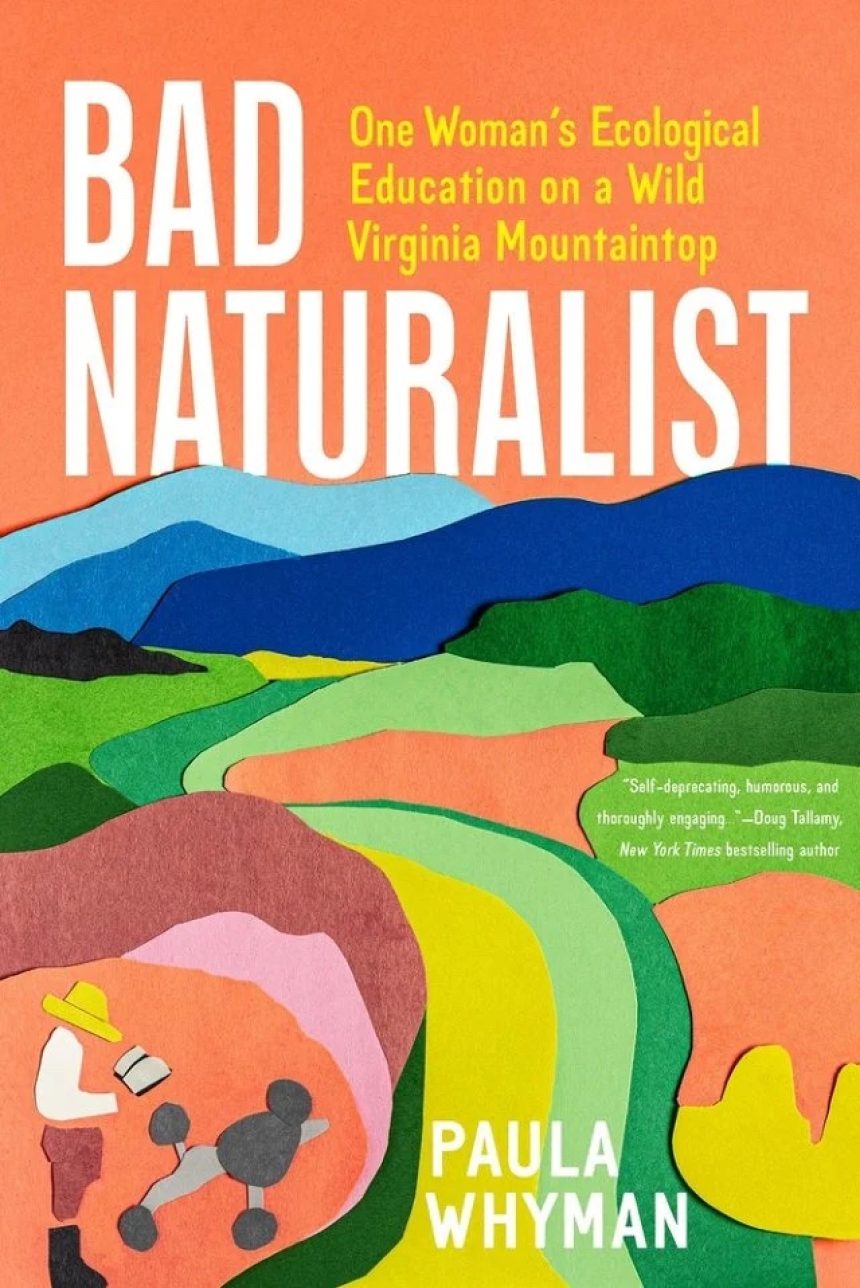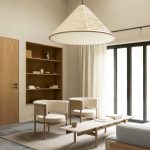Some three years ago, the writer Paula Whyman fulfilled her dream of buying a plot of land in the Blue Ridge Mountains of Virginia—but got a little more than she bargained for in two hundred acres of long-untended former farmland and cow pasture on a mountain. Undeterred by her own checkered gardening history, she set about the gargantuan task of restoring the acreage to its former glory, combatting invasive species, and finding her own place among the interconnected web of grasses and trees, birds, bears, and stick bugs.
Bad Naturalist, Whyman’s first memoir and foray into nonfiction is an account—peppered with self-deprecating, relatable humor—of this yearslong quest, during which she learns to embrace her failures and the chaos of it all. “If you somehow, against the odds, can guide a natural place to a perfect moment, exactly what you were aiming for…you might be able to keep it that way, briefly,” she writes. “But we’re talking about nature, by definition ever evolving, ever changing. I can’t control the climate, the wind, where plants decide to grow, the creatures that carry seeds on their feathers and fur and in their droppings and leave them where I don’t want them, the neighbor who likes those pretty invasive trees with the big purple flowers, the nurseries that sell nonnative plants that escape gardens and end up here, the meandering stream that distributes weed seeds along its banks. I can’t keep the land one way forever.”
Below, we caught up with the author, who has recently finished her house on the edge of the property, about some of her more memorable misadventures and her advice on creating a sanctuary for nature in your own space, however big or small.
First of all, we need to talk about how you got struck by lighting while working on this book.
Well, I wasn’t on the mountain when that happened, but I was working on the book. I was at an artist residency in Virginia in an old converted dairy barn, and it had a concrete floor. There was this massive dramatic lightning storm, and I stupidly had my computer plugged in. The lightning must have come through the floor or through the cable or something. I had my hands on the laptop and it knocked me back out of my chair and shot up my arm. I feel like the lightning strike nudged me in different directions with the book and with my writing in general.
What was your writing process like up on the mountain?
It was a new challenge for me to try to write about the work while I was doing the work on the mountain. I’d walk around in the field with a journal and make little doodles and take photos. I would make these little discoveries by wandering around in nature, and while I was doing things like weeding and mulching, that would inspire things that I would then bring back to my desk and write about. I also did a lot of sitting at my desk and thinking back about moments in my childhood, and I would just write them down. For example, I remembered my dad accidentally setting fire to a crabapple tree and asked myself, How does this tie to the prescribed fire on the mountain I’m writing about? I would write long and cut drastically. My editor called me a meanderer.
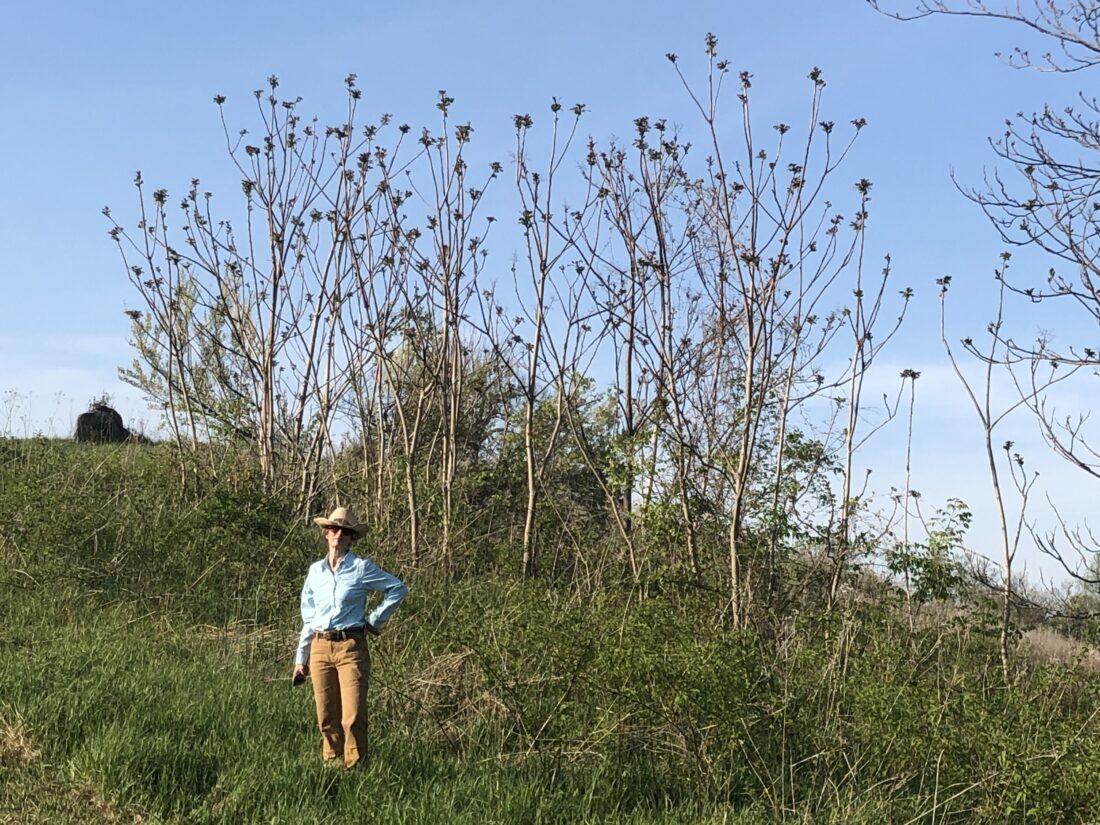
Paula Whyman.
In reflecting so much about your own life while working the land, do you find that you psychologically wove yourself into this place?
I really did. The more I learned about the interconnections between the plants and the creatures that live here, the more I really felt like a part of things. Anytime I would make a bad mistake with the work that I was doing, I would be reminded again that my impact isn’t just what I want it to be.
I’ve lived in the city. I’ve lived in the suburbs. I’m now living on the mountain. At some point, I realized that when I was living in the suburbs and to some extent in the city, although I was always really into ecology and into insects and birds and all of that, I also was a control freak about it. It was all about the pests, all about what was trying to get into my house, or the mosquitoes in my yard or the rats, and not about what was good.
We erect these shields around ourselves. We’re really good at that because we have these big brains. We’re very territorial. How can we change our perspective to feel like we don’t have to go somewhere to be in nature? I used to look at it as seeing cool things in nature is what I do when I travel, as opposed to appreciating nature right where I am.
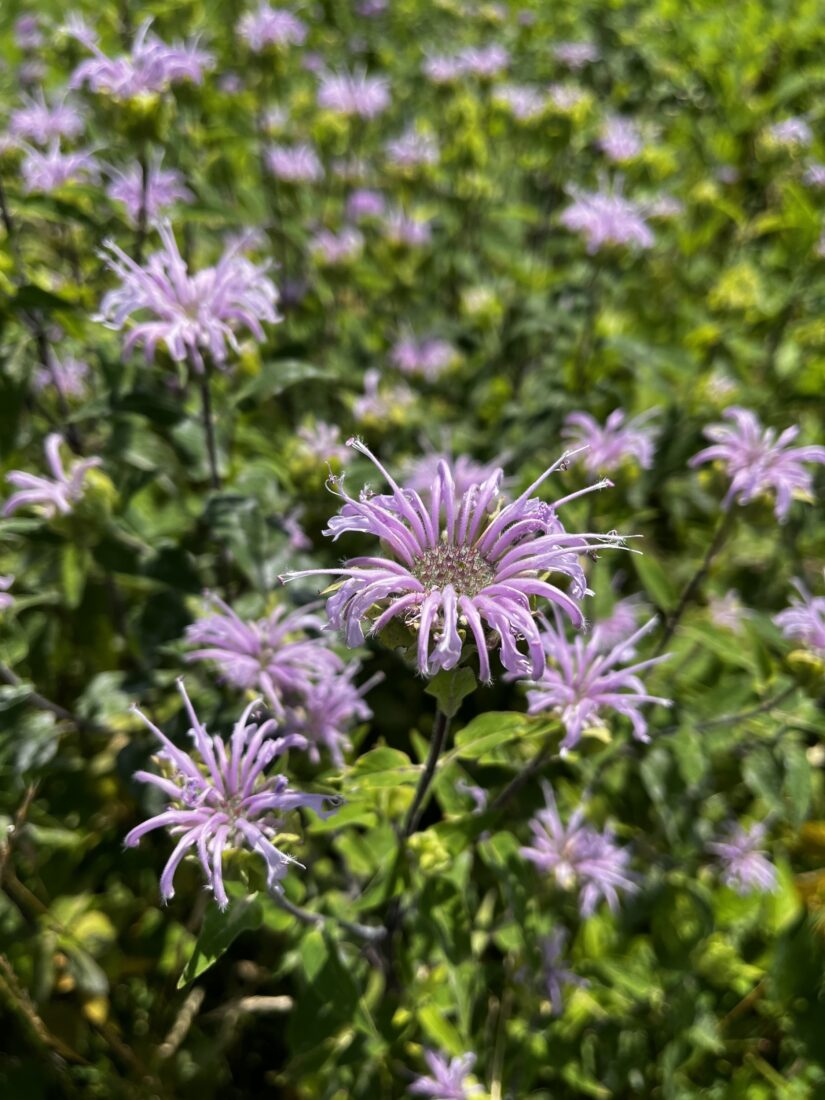
Native bee balm.
Now that you’re actually living on the mountain, has it been what you hoped? I’m sure it’s great, and hard.
It’s amazing to be able to wake up here because before I was driving here to do the work and then going home exhausted at the end of the day. I did that for three years. It’s great to be able to start things early. I spent one day pulling an entire hillside of jimson weed. I felt this real sense of accomplishment. I had filled these two thirty-five-gallon contractor bags, and then I couldn’t move the bags, of course. There’s always something like that. But after I pulled all that, I started seeing native horse nettle, which has yellow fruits that a lot of animals like, so I felt really good about that. Still, I’m absolutely sure that this spring I’m going to see more jimson weed growing.
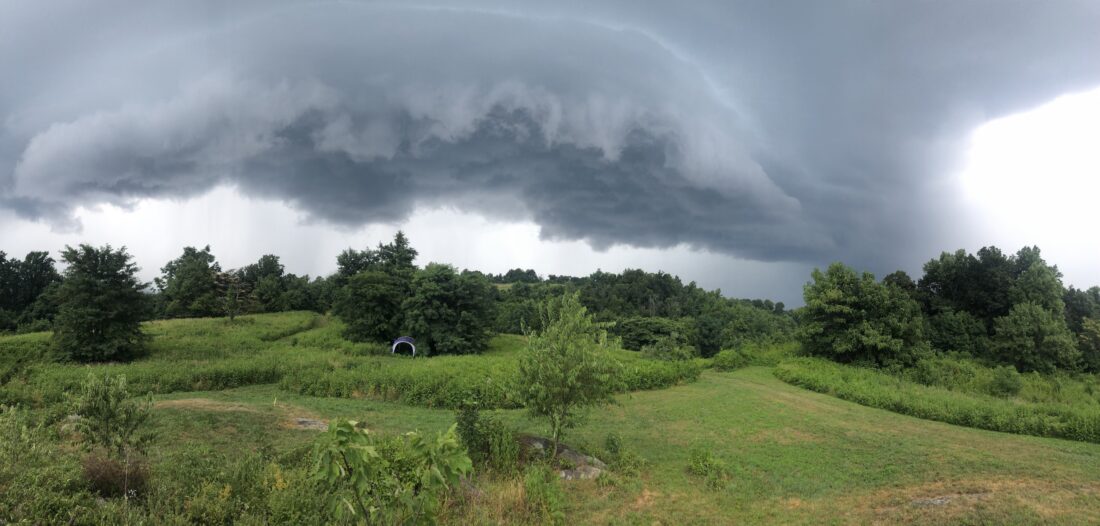
Whyman’s two hundred acre property.
Do you feel you’ve let go of your need for linear progress and a hard end point of success?
I’m definitely never going to be done. And it’s always going to feel like I’m failing at something. I’ll be happy when I can tip the balance closer to 75 percent native plants, and I don’t know how long that will take. I was hoping to get somebody to come up and do a bunch of treatments on invasive trees this winter, but my road has been snow-covered since that snowstorm in early January. And nobody can get up here.
I bet it’s beautiful in the snow.
It is really pretty. I’ve been getting around on snowshoes. Yesterday I pulled two sleds full of groceries up to the house from my truck. If you had asked me a couple of years ago whether this is what I would be using the snowshoes for…I would have said, Oh no, I’m going to be snowshoeing around looking at all the beautiful plants, listening to the sparrows.
Let’s talk about all the wildlife there. What do you see?
I now have two nest boxes for the American kestrel. Apparently they will start hunting for spring nesting ground at this time of year. And I saw one last week! We have a lot of woodcock, bobwhite quail. I’ve heard killdeer. We have sharp-shinned hawks, a lot of migratory birds like common yellowthroat, indigo buntings, and chat. And I’ve added bluebird boxes. I also love learning about new insects. I see stick insects and lots of interesting caterpillars.
There’s a chance we may have a fisher cat, which is like a giant weasel. Someone who would know saw a footprint here. I’d be excited about that. On our trail cam we’ve seen bobcats, coyotes, foxes, bears, thousands of deer, and this awesome raccoon that likes to walk back and forth in front of our door.
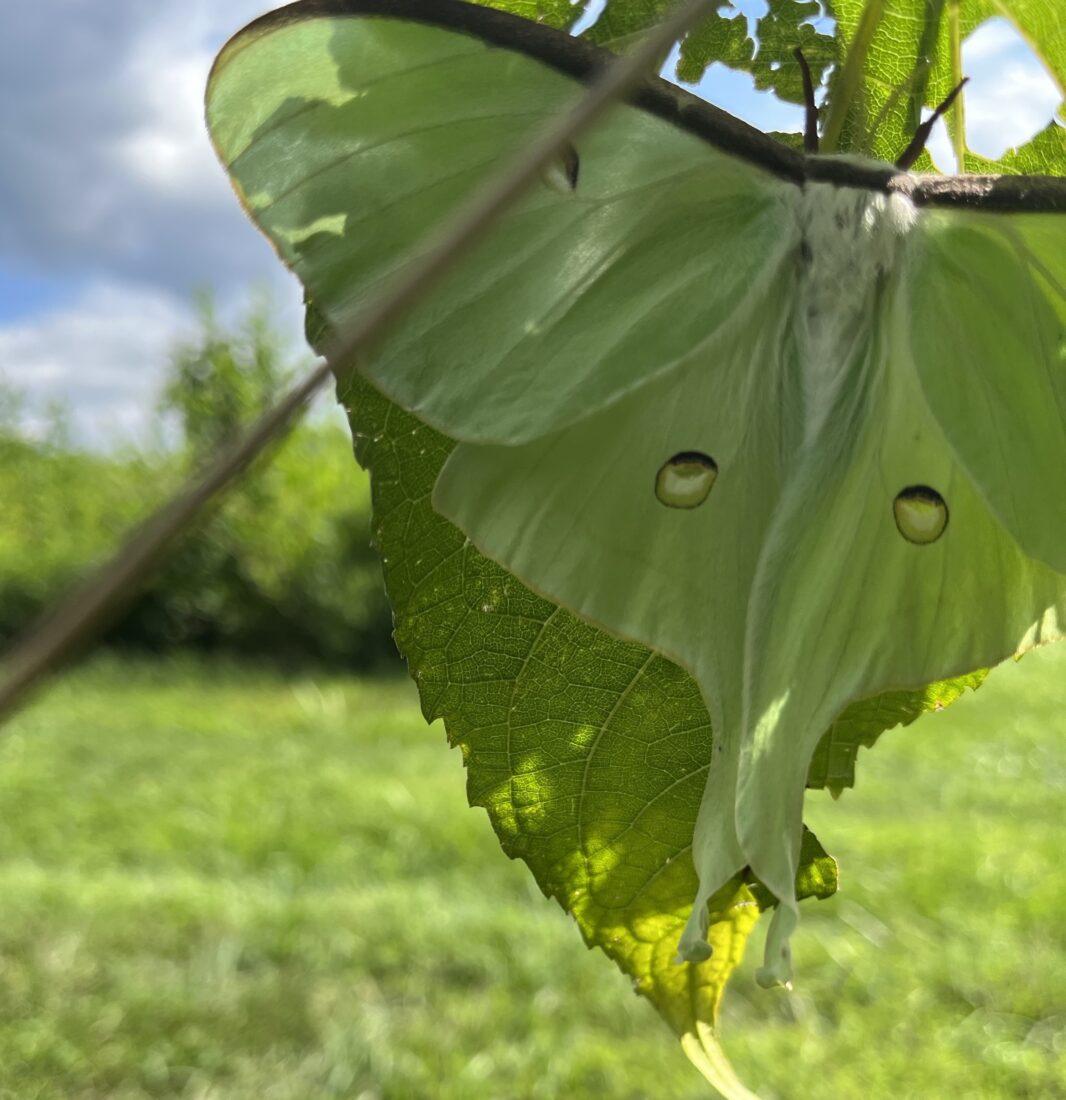
A luna moth.
What advice do you have for the average person in terms of creating a space for nature?
I’m hearing from a lot of people who are interested in doing the same thing or trying to do the same thing in everything from a tiny yard to a big place. I think it all starts with observing, with just paying attention to what’s there and what is desirable and what is undesirable. Anywhere you find yourself, whether it’s in the city or not, take your time and look in a way you haven’t before—at the plants growing along the sidewalk, the birds landing on the wires. Become more curious. See what your interests are. If you’re into birds, plant something native that’s supposed to attract birds. If you’re into butterflies, plant something native that will bring them.
Start simple. Put one thing in your window box or in the pot on your patio or in the corner of your yard where nothing’s really happening, and see what comes to it. And you may be really surprised…and you can say to yourself that thing—the bird or the insect or whatever—wouldn’t have come here if you hadn’t done that. That’s very empowering and motivating. It’s like a gateway drug that leads to more action.
And before you know it, you’re on a mountain in Virginia with two hundred acres.
Right? Honestly, I love it. It’s absolutely beautiful. It’s a gift to be able to wake up here.

